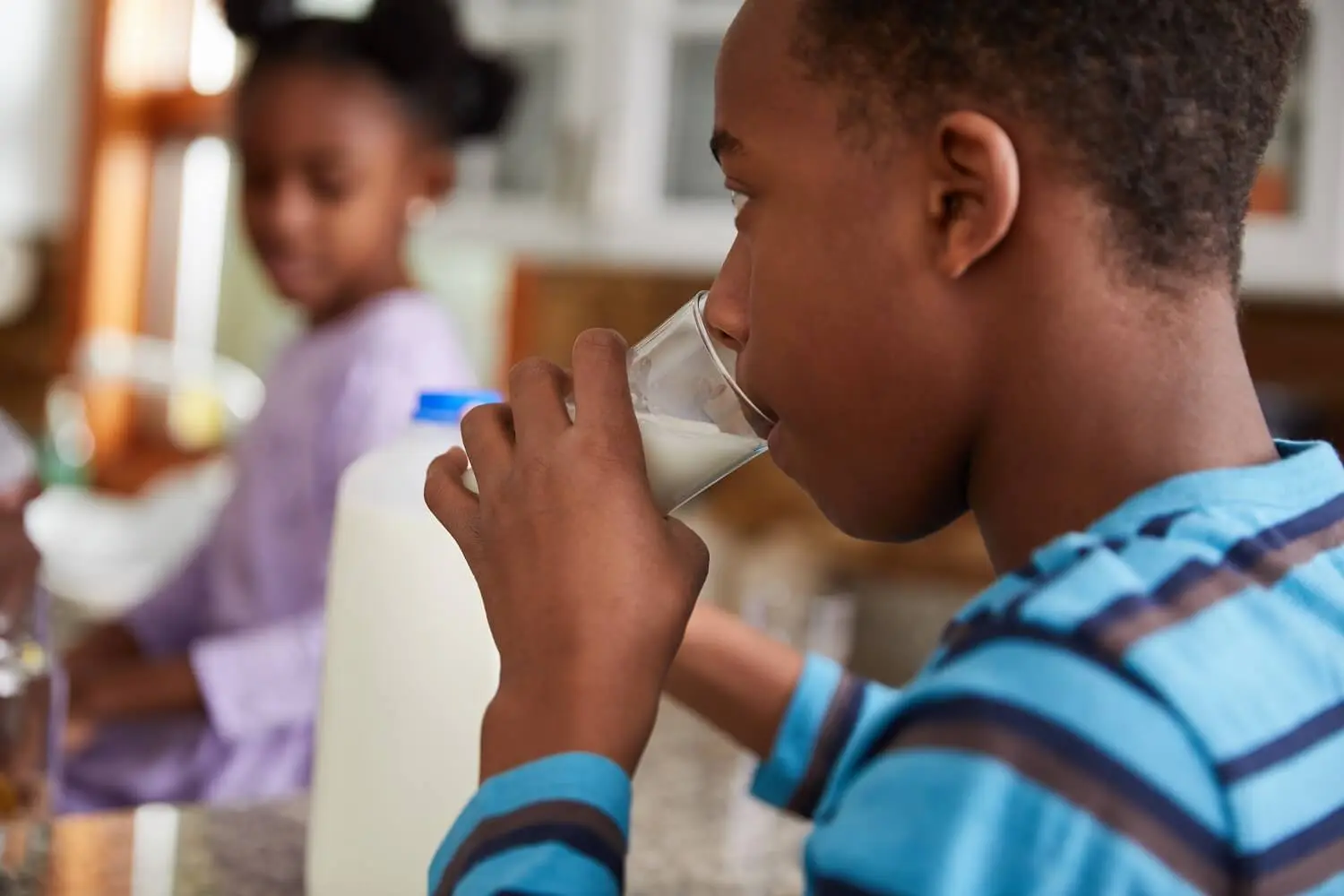Is Milk Good for You?
Whether you’re age 2 or 92, there are many reasons to drink milk. There’s the taste, of course, and research continues to uncover benefits. Want to increase your protein intake? What about your brain health?
You might be most familiar with milk's bone-building reputation. But did you know that's the case for children and for adults? While milk's skeleton-building specs might be long-established, today's science continues to tell us just how it can help.
For example, a 2023 meta-analysis found that when children consume dairy foods, it can positively impact their bone mineral mass. And a 2022 meta-analysis found that milk supplementation was associated with small but significant improvements in spine and hip bone mineral density in adults.
Milk's Nutritional Benefits
There are more benefits! To begin with, milk contains 13 essential nutrients including high-quality protein, calcium, and vitamin D. Milk's nutrients help our bodies function properly. For example:
- Milk's high-quality protein means it contains all nine essential amino acids. The whey protein in milk helps us recover and build muscle after exercise while its casein protein helps us feel full and supports weight management.
- Protein, zinc, selenium and vitamins A and D help support a healthy immune system.
Milk also contains the following B vitamins, which can help your body convert food into fuel:
- Vitamin B-12
- Riboflavin (B2)
- Pantothenic acid (B5)
- Niacin (B3)
In fact, milk is the number-one food source of 13 essential nutrients for children and six essential nutrients for adults. Data from the National Health and Nutrition Examination Survey (NHANES 2011-2014) shows that, on average, that dairy foods (milk, cheese and yogurt) provide more than 50 percent of the calcium and vitamin D in the diets of Americans aged 2 and older, and about a quarter of the vitamin A, vitamin B12, phosphorus and riboflavin per day.
More recent research indicates further gains from drinking milk, like:
- Hydration: Move over sports drinks and water. Milk’s combination of water, natural electrolytes and macronutrients help us rehydrate and improve our net fluid balance. A 2020 study found that milk-based drinks had higher beverage hydration index scores than water and traditional sports drinks.
- Cognitive Benefits: Drinking milk may help protect the brain from the effects of aging. A 2022 study found that older adults who drank three cups of milk a day had higher levels of glutathione, a powerful antioxidant that can promote brain health as we age.
Milk Benefits for Healthy Aging
A new study funded by various agencies including the National Institutes of Health published in The American Journal of Clinical Nutrition found that blood markers related to eating whole and reduced-fat dairy foods like milk, cheese and yogurt were not associated with the risk of death or dying from cardiovascular disease (CVD) events and may even be linked to some health benefits.
This 22-year prospective study included 2,907 adults 65 years and older. The researchers measured markers of dairy fat consumption (pentadecanoic [C15:0], heptadecanoic [C17:0] and trans palmitoleic [trans-16:1, n-7] fatty acids) between long intervals at baseline, six and thirteen years. The results showed those with higher blood levels of these fatty acids, presumably related to consuming whole and reduced-fat dairy foods (such as milk, cheese, yogurt and butter), were not linked to higher risk of death or dying from CVD or stroke when compared to those with lower levels of these blood markers. Additionally, higher blood levels of C17:0 were associated with lower risk of CVD and stroke.
The study aligns with the recent emerging research in the area of fat and overall health outcomes. Previous studies using a similar approach, but in middle-aged people, found comparable findings. However, an important strength from this new study is the use of serial fatty acid measurements. This allows for better assessment of long-term impact of fat from dairy foods for an objective indication of long-term exposure. Therefore, these new findings suggest no negative association of consuming fat from dairy foods and death from CVD events later in life. In fact, certain fatty acids found in dairy foods (e.g., C17:0) were associated with a lower risk of CVD and stroke mortality.
This study adds to the greater body of science showing that in healthy adults dairy foods, regardless of fat, can be part of a calorie-balanced healthy eating plan.
The 2020-2025 Dietary Guidelines for Americans continues to recommend low-fat and fat-free dairy foods, but they also allow up to 10 percent of daily calories coming from saturated fat. That means moderate amounts of whole milk dairy can be part of an overall healthy eating plan as long as you balance consumption with other foods containing saturated fat.
Milk Benefits for Sports Recovery
Milk provides many important nutrients needed for overall health. Recently, a numeber of studies have shown that milk's powerful nutrient package has several benefits for post-exercise recovery. In fact, this emerging reserach shows that drinking milk after exercise can be as effective as some sports drinks in helping the body refuel, recover and rehydrate.
Is Milk Bad For You Based On Scientific Research?
No, milk is not bad for you based on scientific research. In a modeling study, when researchers removed one serving of dairy foods from USDA food patterns for Americans 9 years or older, they found that calcium, magnesium, phosphorus, vitamins A and D dropped significantly. Replacing dairy foods with other food sources high in calcium within a healthy diet pattern would require a significant change in most Americans' eating habits. This would, as examples, equate to having more than one serving of a fortified soy beverage or bony fish or more than two servings of leafy greens just to equal the calcium in one cup of milk.
Understanding Types of Milk
You may be acquainted with the primary types of dairy milks you can purchase at the store: whole milk, reduced-fat milk (2%), low-fat milk (1%) and fat-free milk (skim).
Fat level aside, all dairy milk (including chocolate milk) contains the same 13 essential nutrients – the only difference is the amount of butterfat they contain. How is this done? Before milk is bottled, all of the fat is removed. It’s then re-added to the milk in the various percentages. None of these milks are watered down.
Note that while whole milk is higher in saturated fat, growing research shows it still offers cardiometabolic benefits, likely due to its unique dairy food matrix (a term describing the composition of nutrients, bioactive constituents, and other compounds in dairy, as well as how they are packaged).
A 2023 study of nearly 245,000 adults from 80 countries found that following a healthy dietary pattern, including whole-fat dairy, was associated with heart health and longevity.
Is Drinking Milk Good For You When Lactose Intolerant?
There's also lactose-free milk, which is just like regular milk but without the lactose which is great for those who have trouble digesting this particular sugar. This milk contains all the same essential nutrients as the regular stuff, and you can find out more here.
Are Milk Alternatives Good For You?
A study found that milk alternatives might not give kids enough vitamin D. The study, published in the Canadian Medical Association Journal, found that young children who drank milk alternatives, such as almond, soy or rice milk, were more likely to have low levels of vitamin D in their blood.
Researchers collected information on the amounts and types of milk consumed by nearly 3,000 preschoolers who had tests for vitamin D levels. They found low vitamin D levels in 5 percent of children who drank only cow's milk, compared to 11 percent of children who drank only the milk alternatives.
Some manufacturers fortify milk and other foods with vitamin D, which helps with strong bones and teeth. Milk also naturally contains 13 essential nutrients, including vitamin D, calcium and protein.
"Unlike cow's milk you find in your store, you cannot be certain that essential nutrients are found among the various types of non-dairy beverages," said Stephanie Cundith, a registered dietitian with the Midwest Dairy Council. "That's why I rely on cow's milk to provide my son with the essential nutrients he needs for healthy development."
Is Milk Good or Bad for Acne?
While some observational studies may have presented a link between dairy and increased risk of acne; these studies need to be evaluated through clinical trials to determine cause and effect. The fact is the body of research to date does not show cause and effect that diet, or any particular food, causes acne.
In fact, according to the American Academy of Dermatology, a balanced, nutrient-rich eating plan can help keep skin healthy. Dairy foods, like low-fat and fat-free milk, cheese and yogurt, are an important part of a healthy eating plan, with milk providing a unique package of 13 essential nutrients. Removing dairy foods, or any food group for that matter, from your eating plan can actually have a negative impact on nutrient consumption.
So, rather than focusing on removing specific foods to promote healthy skin, concentrate on a healthy balanced eating plan that contains all food groups, including dairy foods. If you are concerned about acne, please consult a dermatologist for appropriate treatment, but remember that you can still enjoy dairy!
Milk's Frequently Asked Questions
Now that milk's on your mind, you may have other questions, like:
Does milk have added sugar?
White milk does not; the sugar in milk comes from the naturally occurring lactose. An 8-ounce serving of regular milk contains 12 grams of naturally occurring sugar – the same amount in a small banana. Chocolate milk and other flavored milks may have some added sugar.
What is carrageenan?
Carrageenan is a seaweed extract that can be used to thicken foods, such as chocolate milk, yogurt and ice cream.
What do milk fat percentages mean?
Milk fat percentages (specifically 1% and 2%) refer to the amount of butterfat in the milk by weight. Whole milk, which is the closest to what it would be coming from a cow, is about 3.5% fat. Fat-free or skim milk contains very little fat - less than 0.2%!
What is ultra-high temperature milk?
Ultra-high temperature (UHT) milk is real milk that has been ultra-pasteurized (heated at or above 280 degrees for at least 2 seconds) and packaged in a way that it can last for several months on the shelf unrefrigerated.
Why is vitamin D added to milk?
It all goes back to 1922, thanks to a discovery that found adding vitamin D to calcium-rich milk could help build and maintain children’s bones.
Explore our FAQs for answers to common questions and dive deeper into the world of milk.
















